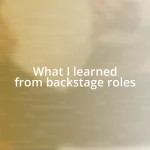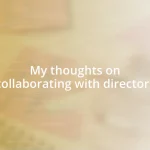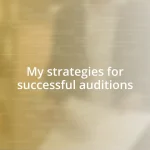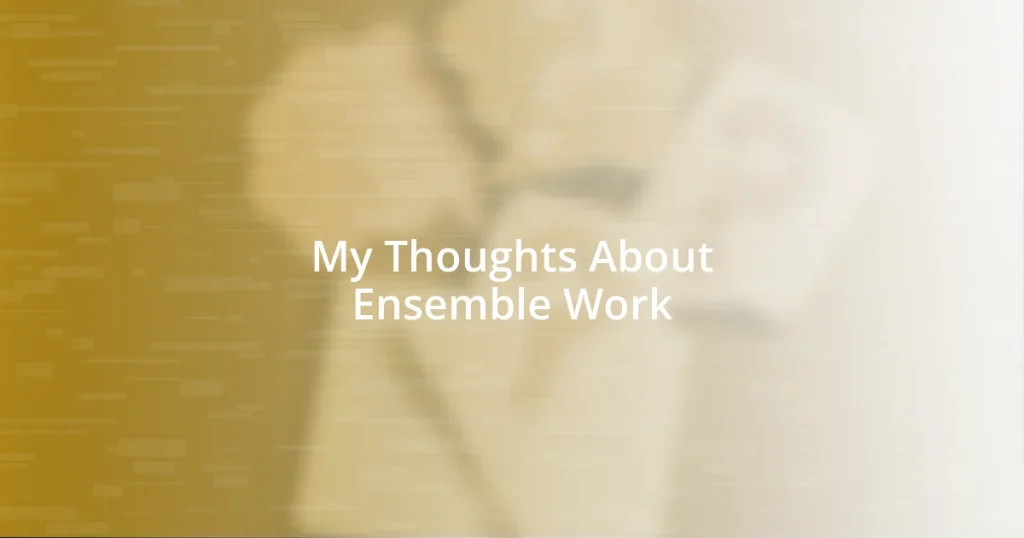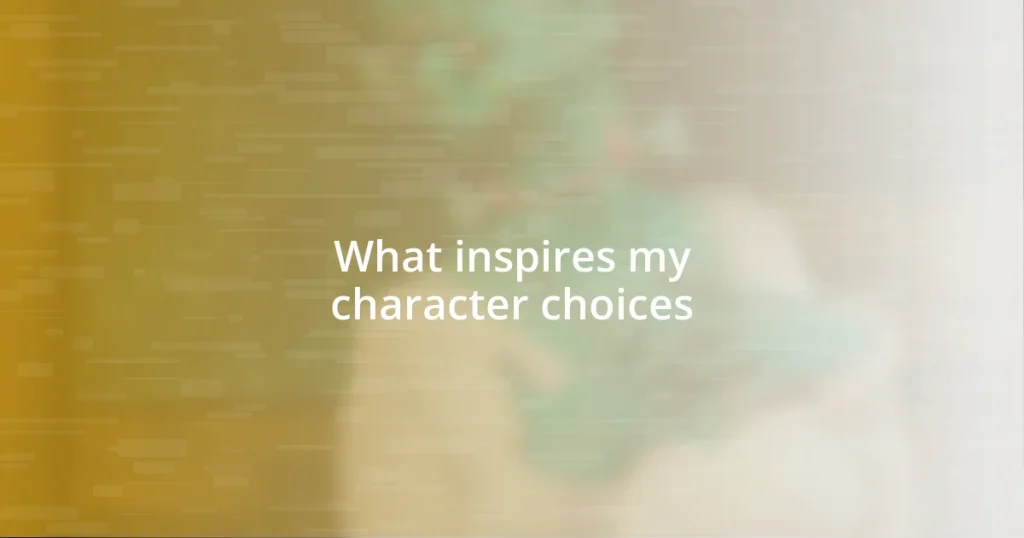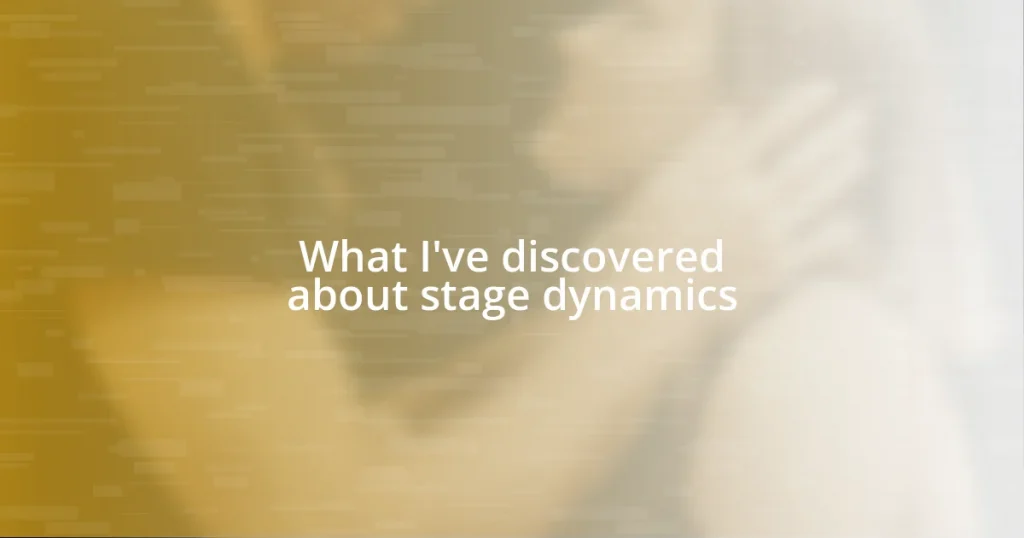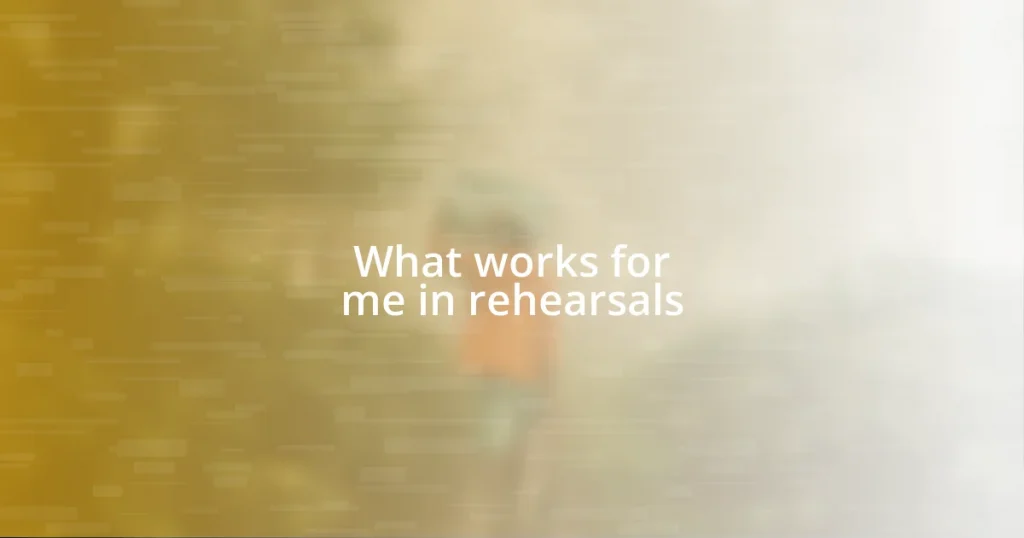Key takeaways:
- Collaboration in ensembles fosters creativity and personal growth, enhancing the quality of outcomes through shared accountability.
- Effective communication is crucial for building trust, minimizing misunderstandings, and facilitating problem-solving, driving project success.
- Establishing clear roles, regular check-ins, and a feedback culture are essential strategies for improving teamwork and enhancing collective creativity.

Understanding ensemble work benefits
When I first joined an ensemble, I was amazed by how collaboration could spark creativity. Working with diverse perspectives not only enriched our projects but also fostered an atmosphere of support and trust. Have you ever felt that thrill when a group converges on a new idea? It’s invigorating!
Another benefit of ensemble work is the opportunity for personal growth. I remember a particular project where I was pushed out of my comfort zone. Learning to adapt my communication style to fit the group taught me valuable lessons about flexibility and understanding others. Isn’t it fascinating how much we can learn from those around us?
Moreover, ensemble work often leads to higher-quality outcomes. When everyone contributes their unique strengths, the final product can truly shine. I’ve seen firsthand how shared accountability encourages us to elevate our standards and produce work that we can all take pride in. Don’t you think that together we can achieve what feels impossible on our own?

Importance of communication in ensembles
Effective communication in ensembles is the linchpin that binds creativity and collaboration. I recall during one of our rehearsals, there was a moment when two members had conflicting ideas about the project’s direction. Instead of letting it fester, we all took a breath and discussed our perspectives openly, leading to a unique fusion of ideas that bore fruit beyond our expectations. The ability to share thoughts without fear is what transformed that tension into a pivotal moment of synergy.
- Encourages trust among members, creating a safe space for expressing ideas.
- Minimizes misunderstandings, ensuring everyone is on the same page.
- Enables the group to leverage diverse skills and insights effectively.
- Facilitates problem-solving by allowing collective brainstorming.
- Enhances relationships, fostering a sense of belonging and investment in the project.
I think that when communication flows seamlessly, it inspires a momentum that is hard to replicate. In another instance, our team faced tight deadlines, and the pressure was palpable. By maintaining open lines of communication about our progress and concerns, we stayed aligned and managed to not only meet the deadline but exceed our own expectations. That experience taught me how vital transparency is in keeping everyone motivated and focused on the common goal.

Strategies for effective team collaboration
One of the most effective strategies for team collaboration I’ve found is establishing clear roles and responsibilities. When I worked on a collaborative project last year, we took time upfront to define who would handle specific tasks. This clarity enabled us to focus on our strengths and hold each other accountable. Have you noticed how comfortable it feels when everyone knows their part? It’s liberating and boosts productivity.
Another key approach is to prioritize regular check-ins. I remember when we instituted weekly meetings where we shared progress updates and hurdles. This practice not only kept everyone informed but also forged deeper connections among team members. I could see the difference it made in morale; the camaraderie blossomed, and we felt more like a unit tackling challenges together. Wouldn’t you agree that shared moments can transform a group into a cohesive team?
Finally, fostering a culture of feedback makes collaboration thrive. In one instance, after sharing a draft for our performance, we encouraged everyone to provide constructive criticism. The feedback was invaluable, ultimately refining our work into something much richer than I could have envisioned alone. I’ve learned that welcoming feedback not only improves outcomes but also nurtures a sense of shared ownership and investment in the project. Isn’t it incredible how a simple act of openness can elevate everyone involved?
| Strategy | Key Benefits |
|---|---|
| Clear Roles | Enhances focus and accountability |
| Regular Check-ins | Builds connections and maintains alignment |
| Feedback Culture | Improves outcomes and fosters shared ownership |
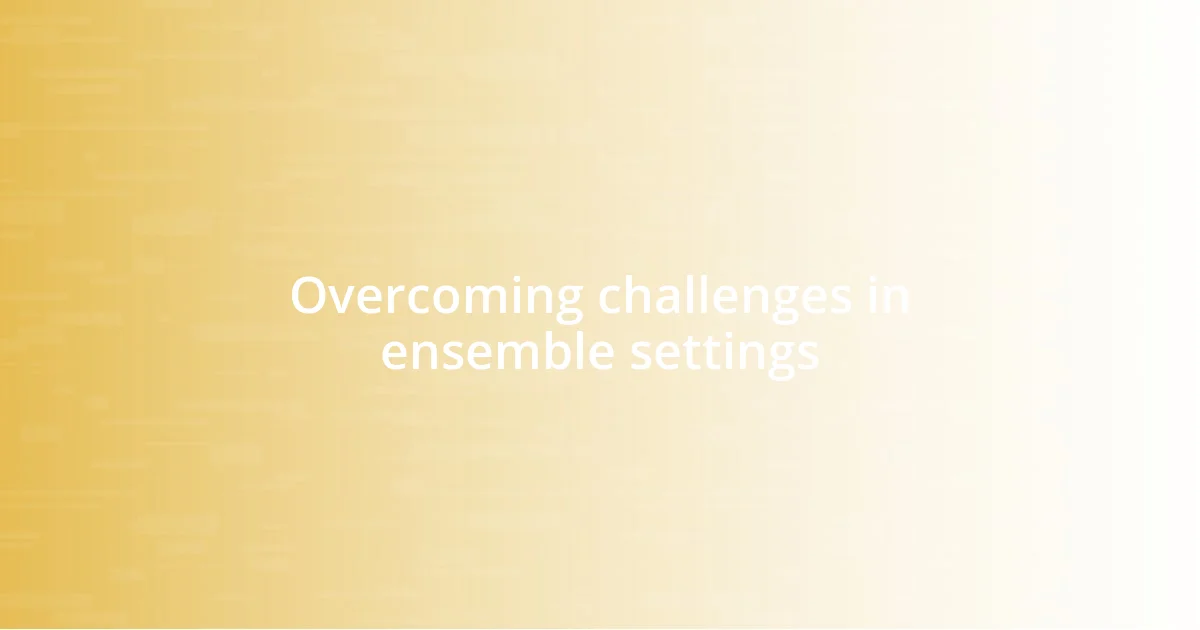
Overcoming challenges in ensemble settings
Navigating challenges in ensemble settings can sometimes feel like walking a tightrope, especially when differing opinions clash. I remember a particularly challenging rehearsal when we hit an impasse over a musical arrangement. It was frustrating, and I could sense the mounting tension in the room. By sharing our individual perspectives, we uncovered a shared vision that blended our ideas seamlessly — a reminder that sometimes, a bit of friction can lead to a spark of creativity.
One thing I’ve noticed is the importance of emotional intelligence among ensemble members. For instance, during another project, a teammate appeared withdrawn after receiving criticism. Rather than pushing forward, I took the initiative to check in with them, leading to a heart-to-heart conversation that restored their confidence and engagement in the group. What I’ve learned is that taking time to understand each other’s emotional landscapes not only helps resolve conflicts but also strengthens our bond as a team.
Unexpected challenges can also arise from external pressures, such as performance anxiety. I once experienced this firsthand before a big show, where our nerves began to impact our cohesion. Instead of letting anxiety run rampant, we decided to engage in a collective breathing exercise — a momentary pause that cleared our minds and unified our focus. Have you ever tried something similar in a stressful moment? The transformation was palpable, reinforcing my belief that addressing emotional challenges collectively can turn a potential setback into a resounding success.

Techniques for enhancing creativity together
One effective technique for enhancing creativity together is brainstorming as a group in an open setting. I recall a session where we surrounded ourselves with inspirational art and music, encouraging everyone to share their wildest ideas without judgment. The energy in the room was contagious, and I felt a surge of excitement as even the quietest members contributed innovative thoughts. Have you ever noticed how a change in environment can elevate everyone’s creativity?
Another technique I find valuable is the power of collaborative storytelling. During a recent workshop, we challenged ourselves to build a narrative together, with each member contributing a line or idea. This process not only sparked unexpected connections between our concepts but also allowed us to see the project from fresh perspectives. I was amazed at how quickly we crafted a cohesive story that was richer than any of our individual contributions could have achieved. Isn’t it fascinating how storytelling can weave us closer together?
Lastly, incorporating play into our work can be transformative. I remember a time when we dedicated an afternoon to play improv games aimed at loosening up our minds. The laughter and spontaneity created an atmosphere of trust and openness. It’s surprising how letting our guard down can unlock a floodgate of creativity, allowing us to explore ideas that may have felt too risky otherwise. Have you ever felt the creative magic that comes from just playfully engaging with your team? It’s an experience worth seeking out.



